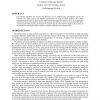Free Online Productivity Tools
i2Speak
i2Symbol
i2OCR
iTex2Img
iWeb2Print
iWeb2Shot
i2Type
iPdf2Split
iPdf2Merge
i2Bopomofo
i2Arabic
i2Style
i2Image
i2PDF
iLatex2Rtf
Sci2ools
IDA
2000
Springer
2000
Springer
Induction of decision trees in numeric domains using set-valued attributes
Conventional algorithms for decision tree induction use an attribute-value representation scheme for instances. This paper explores the empirical consequences of using set-valued attributes. This simple representational extension is shown to yield significant gains in speed and accuracy. To do so, the paper also describes an intuitive and practical version of pre-pruning. This method is shown to yield considerably better accuracy results when used as a pre-processor for numeric data. It is also shown to improve the accuracy for the second best classification option, which has valuable ramifications for post-processing.
Attribute-value Representation Scheme | Decision Tree Induction | IDA 2000 | Information Technology | Simple Representational Extension |
| Added | 18 Dec 2010 |
| Updated | 18 Dec 2010 |
| Type | Journal |
| Year | 2000 |
| Where | IDA |
| Authors | Dimitrios Kalles, Athanassios Papagelis, Eirini Ntoutsi |
Comments (0)

